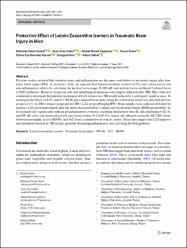| dc.contributor.author | Günal, Mehmet Yalçın | |
| dc.contributor.author | Şakul, Ayşe Arzu | |
| dc.contributor.author | Çağlayan, Ahmet Burak | |
| dc.contributor.author | Erten, Füsun | |
| dc.contributor.author | Durmaz Kurşun, Öznur Ece | |
| dc.contributor.author | Kılıç, Ertuğrul | |
| dc.contributor.author | Şahin, Kazım | |
| dc.date.accessioned | 2021-10-19T12:52:45Z | |
| dc.date.available | 2021-10-19T12:52:45Z | |
| dc.date.issued | 2021 | en_US |
| dc.identifier.citation | Günal, M. Y., Şakul, A. A., Çağlayan, A. B., Erten, F., Durmaz Kurşun, Ö. E., Kılıç, E. ... Şahin, K. (2021). Protective effect of lutein/zeaxanthin isomers in traumatic brain injury in mice. Neurotoxicity Research, 39(5), 1543-1550. https://dx.doi.org/10.1007/s12640-021-00385-3 | en_US |
| dc.identifier.issn | 1029-8428 | |
| dc.identifier.issn | 1476-3524 | |
| dc.identifier.uri | https://dx.doi.org/10.1007/s12640-021-00385-3 | |
| dc.identifier.uri | https://hdl.handle.net/20.500.12511/8472 | |
| dc.description.abstract | Previous studies revealed that oxidative stress and inflammation are the main contributors to secondary injury after traumatic brain injury (TBI). In an earlier study, we reported that lutein/zeaxanthin isomers (L/Zi) exert antioxidative and anti-inflammatory effects by activating the nuclear factor-kappa B (NF-kappa B) and nuclear factor-erythroid 2-related factor 2 (Nrf2) pathways. However, its precise role and underlying mechanisms were largely unknown after TBI. This study was conducted to investigate the potential mechanism of L/Zi isomers in a TBI model induced by a cold injury model in mice. To investigate the effects of L/Zi, male C57BL/6j mice-induced brain injury using the cold trauma model was allocated into two groups (n = 7): (i) TBI + vehicle group and (ii) TBI + L/Zi group (20 mg/kg BW). Brain samples were collected 24 h later for analyses. L/Zi given immediately after the injury decreased infarct volume and blood-brain barrier (BBB) permeability; L/Zi treatment also significantly reduced proinflammatory cytokines, including interleukin1 beta (IL-1 beta), interleukin 6 (IL-6), and NF-kappa B levels and increased growth-associated protein 43 (GAP-43), neural cell adhesion molecule (NCAM), brain-derived neurotrophic factor (BDNF), and Nrf2 levels compared with vehicle control. These data suggest that L/Zi improves mitochondrial function in TBI models, possibly decreasing inflammation and activating the Nrf2 pathway. | en_US |
| dc.description.sponsorship | OmniActive Health Technologies, NJ, USA ; Turkish Academy of Sciences | en_US |
| dc.language.iso | eng | en_US |
| dc.publisher | Springer | en_US |
| dc.rights | info:eu-repo/semantics/embargoedAccess | en_US |
| dc.subject | BDNF | en_US |
| dc.subject | Lutein/Zeaxanthin Isomers | en_US |
| dc.subject | NF-κB | en_US |
| dc.subject | Nrf2 | en_US |
| dc.subject | Traumatic Brain Injury | en_US |
| dc.title | Protective effect of lutein/zeaxanthin isomers in traumatic brain injury in mice | en_US |
| dc.type | article | en_US |
| dc.relation.ispartof | Neurotoxicity Research | en_US |
| dc.department | İstanbul Medipol Üniversitesi, Rektörlük, Rejeneratif ve Restoratif Tıp Araştırmaları Merkezi (REMER) | en_US |
| dc.department | İstanbul Medipol Üniversitesi, Tıp Fakültesi, Dahili Tıp Bilimleri Bölümü, Tıbbi Farmakoloji Ana Bilim Dalı | en_US |
| dc.department | İstanbul Medipol Üniversitesi, Tıp Fakültesi, Temel Tıp Bilimleri Bölümü, Fizyoloji Ana Bilim Dalı | en_US |
| dc.authorid | 0000-0001-7702-2441 | en_US |
| dc.authorid | 0000-0002-9354-0000 | en_US |
| dc.authorid | 0000-0002-6242-3709 | en_US |
| dc.authorid | 0000-0001-6494-8923 | en_US |
| dc.identifier.volume | 39 | en_US |
| dc.identifier.issue | 5 | en_US |
| dc.identifier.startpage | 1543 | en_US |
| dc.identifier.endpage | 1550 | en_US |
| dc.relation.publicationcategory | Makale - Uluslararası Hakemli Dergi - Kurum Öğretim Elemanı | en_US |
| dc.identifier.doi | 10.1007/s12640-021-00385-3 | en_US |
| dc.identifier.wosquality | Q2 | en_US |
| dc.identifier.scopusquality | Q2 | en_US |


















